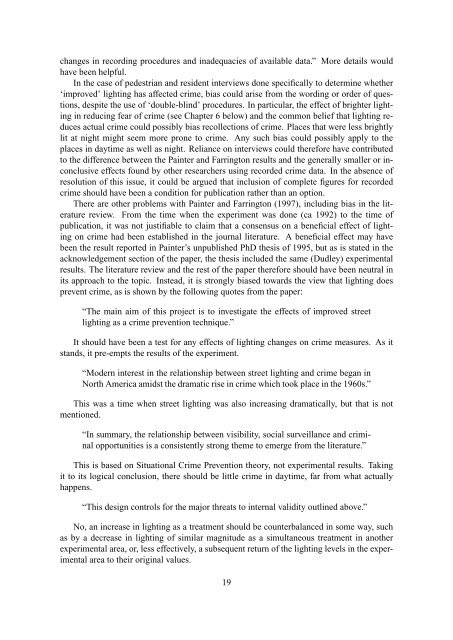outdoor lighting and crime, part 1 - Astronomical Society of Victoria
outdoor lighting and crime, part 1 - Astronomical Society of Victoria
outdoor lighting and crime, part 1 - Astronomical Society of Victoria
Create successful ePaper yourself
Turn your PDF publications into a flip-book with our unique Google optimized e-Paper software.
changes in recording procedures <strong>and</strong> inadequacies <strong>of</strong> available data.” More details would<br />
have been helpful.<br />
In the case <strong>of</strong> pedestrian <strong>and</strong> resident interviews done specifically to determine whether<br />
‘improved’ <strong>lighting</strong> has affected <strong>crime</strong>, bias could arise from the wording or order <strong>of</strong> questions,<br />
despite the use <strong>of</strong> ‘double-blind’ procedures. In <strong>part</strong>icular, the effect <strong>of</strong> brighter <strong>lighting</strong><br />
in reducing fear <strong>of</strong> <strong>crime</strong> (see Chapter 6 below) <strong>and</strong> the common belief that <strong>lighting</strong> reduces<br />
actual <strong>crime</strong> could possibly bias recollections <strong>of</strong> <strong>crime</strong>. Places that were less brightly<br />
lit at night might seem more prone to <strong>crime</strong>. Any such bias could possibly apply to the<br />
places in daytime as well as night. Reliance on interviews could therefore have contributed<br />
to the difference between the Painter <strong>and</strong> Farrington results <strong>and</strong> the generally smaller or inconclusive<br />
effects found by other researchers using recorded <strong>crime</strong> data. In the absence <strong>of</strong><br />
resolution <strong>of</strong> this issue, it could be argued that inclusion <strong>of</strong> complete figures for recorded<br />
<strong>crime</strong> should have been a condition for publication rather than an option.<br />
There are other problems with Painter <strong>and</strong> Farrington (1997), including bias in the literature<br />
review. From the time when the experiment was done (ca 1992) to the time <strong>of</strong><br />
publication, it was not justifiable to claim that a consensus on a beneficial effect <strong>of</strong> <strong>lighting</strong><br />
on <strong>crime</strong> had been established in the journal literature. A beneficial effect may have<br />
been the result reported in Painter’s unpublished PhD thesis <strong>of</strong> 1995, but as is stated in the<br />
acknowledgement section <strong>of</strong> the paper, the thesis included the same (Dudley) experimental<br />
results. The literature review <strong>and</strong> the rest <strong>of</strong> the paper therefore should have been neutral in<br />
its approach to the topic. Instead, it is strongly biased towards the view that <strong>lighting</strong> does<br />
prevent <strong>crime</strong>, as is shown by the following quotes from the paper:<br />
“The main aim <strong>of</strong> this project is to investigate the effects <strong>of</strong> improved street<br />
<strong>lighting</strong> as a <strong>crime</strong> prevention technique.”<br />
It should have been a test for any effects <strong>of</strong> <strong>lighting</strong> changes on <strong>crime</strong> measures. As it<br />
st<strong>and</strong>s, it pre-empts the results <strong>of</strong> the experiment.<br />
“Modern interest in the relationship between street <strong>lighting</strong> <strong>and</strong> <strong>crime</strong> began in<br />
North America amidst the dramatic rise in <strong>crime</strong> which took place in the 1960s.”<br />
This was a time when street <strong>lighting</strong> was also increasing dramatically, but that is not<br />
mentioned.<br />
“In summary, the relationship between visibility, social surveillance <strong>and</strong> criminal<br />
opportunities is a consistently strong theme to emerge from the literature.”<br />
This is based on Situational Crime Prevention theory, not experimental results. Taking<br />
it to its logical conclusion, there should be little <strong>crime</strong> in daytime, far from what actually<br />
happens.<br />
“This design controls for the major threats to internal validity outlined above.”<br />
No, an increase in <strong>lighting</strong> as a treatment should be counterbalanced in some way, such<br />
as by a decrease in <strong>lighting</strong> <strong>of</strong> similar magnitude as a simultaneous treatment in another<br />
experimental area, or, less effectively, a subsequent return <strong>of</strong> the <strong>lighting</strong> levels in the experimental<br />
area to their original values.<br />
19
















